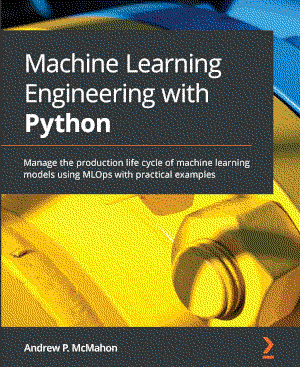Feature Engineering with Open-Source#
In this notebook, the Feature Engineering Pipeline from the Housing Feature Engineering notebook of Machine Learning Preprocessing is used. The manually created functions are replaced by open-source classes.
Missing values
Temporal variables
Non-Gaussian distributed variables
Categorical variables: remove rare labels
Categorical variables: convert strings to numbers
Standardize the values of the variables to the same range
With the aim to ensure reproducibility between runs of the same notebook, and between the research and production environment, for each step that includes some element of randomness, it is extremely important that the seed is set.
1# data manipulation and plotting
2import pandas as pd
3import numpy as np
4import matplotlib.pyplot as plt
5
6# from Scikit-learn
7from sklearn.model_selection import train_test_split
8from sklearn.preprocessing import MinMaxScaler, Binarizer
9
10# from feature-engine
11from feature_engine.imputation import (
12 AddMissingIndicator,
13 MeanMedianImputer,
14 CategoricalImputer,
15)
16
17from feature_engine.encoding import (
18 RareLabelEncoder,
19 OrdinalEncoder,
20)
21
22from feature_engine.transformation import (
23 LogTransformer,
24 YeoJohnsonTransformer,
25)
26
27from feature_engine.selection import DropFeatures
28from feature_engine.wrappers import SklearnTransformerWrapper
29
30# to visualise al the columns in the dataframe
31pd.pandas.set_option("display.max_columns", None)
Paths#
1# Path to datasets directory
2data_path = "./datasets"
3# Path to assets directory (for saving results to)
4assets_path = "./assets"
Loading dataset#
1# load dataset
2data = pd.read_csv(f"{data_path}/train.csv")
3
4# rows and columns of the data
5print(data.shape)
6
7# visualise the dataset
8data.head()
(1460, 81)
| Id | MSSubClass | MSZoning | LotFrontage | LotArea | Street | Alley | LotShape | LandContour | Utilities | LotConfig | LandSlope | Neighborhood | Condition1 | Condition2 | BldgType | HouseStyle | OverallQual | OverallCond | YearBuilt | YearRemodAdd | RoofStyle | RoofMatl | Exterior1st | Exterior2nd | MasVnrType | MasVnrArea | ExterQual | ExterCond | Foundation | BsmtQual | BsmtCond | BsmtExposure | BsmtFinType1 | BsmtFinSF1 | BsmtFinType2 | BsmtFinSF2 | BsmtUnfSF | TotalBsmtSF | Heating | HeatingQC | CentralAir | Electrical | 1stFlrSF | 2ndFlrSF | LowQualFinSF | GrLivArea | BsmtFullBath | BsmtHalfBath | FullBath | HalfBath | BedroomAbvGr | KitchenAbvGr | KitchenQual | TotRmsAbvGrd | Functional | Fireplaces | FireplaceQu | GarageType | GarageYrBlt | GarageFinish | GarageCars | GarageArea | GarageQual | GarageCond | PavedDrive | WoodDeckSF | OpenPorchSF | EnclosedPorch | 3SsnPorch | ScreenPorch | PoolArea | PoolQC | Fence | MiscFeature | MiscVal | MoSold | YrSold | SaleType | SaleCondition | SalePrice | |
|---|---|---|---|---|---|---|---|---|---|---|---|---|---|---|---|---|---|---|---|---|---|---|---|---|---|---|---|---|---|---|---|---|---|---|---|---|---|---|---|---|---|---|---|---|---|---|---|---|---|---|---|---|---|---|---|---|---|---|---|---|---|---|---|---|---|---|---|---|---|---|---|---|---|---|---|---|---|---|---|---|---|
| 0 | 1 | 60 | RL | 65.0 | 8450 | Pave | NaN | Reg | Lvl | AllPub | Inside | Gtl | CollgCr | Norm | Norm | 1Fam | 2Story | 7 | 5 | 2003 | 2003 | Gable | CompShg | VinylSd | VinylSd | BrkFace | 196.0 | Gd | TA | PConc | Gd | TA | No | GLQ | 706 | Unf | 0 | 150 | 856 | GasA | Ex | Y | SBrkr | 856 | 854 | 0 | 1710 | 1 | 0 | 2 | 1 | 3 | 1 | Gd | 8 | Typ | 0 | NaN | Attchd | 2003.0 | RFn | 2 | 548 | TA | TA | Y | 0 | 61 | 0 | 0 | 0 | 0 | NaN | NaN | NaN | 0 | 2 | 2008 | WD | Normal | 208500 |
| 1 | 2 | 20 | RL | 80.0 | 9600 | Pave | NaN | Reg | Lvl | AllPub | FR2 | Gtl | Veenker | Feedr | Norm | 1Fam | 1Story | 6 | 8 | 1976 | 1976 | Gable | CompShg | MetalSd | MetalSd | None | 0.0 | TA | TA | CBlock | Gd | TA | Gd | ALQ | 978 | Unf | 0 | 284 | 1262 | GasA | Ex | Y | SBrkr | 1262 | 0 | 0 | 1262 | 0 | 1 | 2 | 0 | 3 | 1 | TA | 6 | Typ | 1 | TA | Attchd | 1976.0 | RFn | 2 | 460 | TA | TA | Y | 298 | 0 | 0 | 0 | 0 | 0 | NaN | NaN | NaN | 0 | 5 | 2007 | WD | Normal | 181500 |
| 2 | 3 | 60 | RL | 68.0 | 11250 | Pave | NaN | IR1 | Lvl | AllPub | Inside | Gtl | CollgCr | Norm | Norm | 1Fam | 2Story | 7 | 5 | 2001 | 2002 | Gable | CompShg | VinylSd | VinylSd | BrkFace | 162.0 | Gd | TA | PConc | Gd | TA | Mn | GLQ | 486 | Unf | 0 | 434 | 920 | GasA | Ex | Y | SBrkr | 920 | 866 | 0 | 1786 | 1 | 0 | 2 | 1 | 3 | 1 | Gd | 6 | Typ | 1 | TA | Attchd | 2001.0 | RFn | 2 | 608 | TA | TA | Y | 0 | 42 | 0 | 0 | 0 | 0 | NaN | NaN | NaN | 0 | 9 | 2008 | WD | Normal | 223500 |
| 3 | 4 | 70 | RL | 60.0 | 9550 | Pave | NaN | IR1 | Lvl | AllPub | Corner | Gtl | Crawfor | Norm | Norm | 1Fam | 2Story | 7 | 5 | 1915 | 1970 | Gable | CompShg | Wd Sdng | Wd Shng | None | 0.0 | TA | TA | BrkTil | TA | Gd | No | ALQ | 216 | Unf | 0 | 540 | 756 | GasA | Gd | Y | SBrkr | 961 | 756 | 0 | 1717 | 1 | 0 | 1 | 0 | 3 | 1 | Gd | 7 | Typ | 1 | Gd | Detchd | 1998.0 | Unf | 3 | 642 | TA | TA | Y | 0 | 35 | 272 | 0 | 0 | 0 | NaN | NaN | NaN | 0 | 2 | 2006 | WD | Abnorml | 140000 |
| 4 | 5 | 60 | RL | 84.0 | 14260 | Pave | NaN | IR1 | Lvl | AllPub | FR2 | Gtl | NoRidge | Norm | Norm | 1Fam | 2Story | 8 | 5 | 2000 | 2000 | Gable | CompShg | VinylSd | VinylSd | BrkFace | 350.0 | Gd | TA | PConc | Gd | TA | Av | GLQ | 655 | Unf | 0 | 490 | 1145 | GasA | Ex | Y | SBrkr | 1145 | 1053 | 0 | 2198 | 1 | 0 | 2 | 1 | 4 | 1 | Gd | 9 | Typ | 1 | TA | Attchd | 2000.0 | RFn | 3 | 836 | TA | TA | Y | 192 | 84 | 0 | 0 | 0 | 0 | NaN | NaN | NaN | 0 | 12 | 2008 | WD | Normal | 250000 |
Separate dataset into train and test#
Feature engineering techniques:
mean
mode
exponents for the yeo-johnson
category frequency
and category to number mappings
Separating the data into train and test involves randomness, therefore, we need to set the seed.
1# Separate into train and test set.
2# Set the seed (random_state for this sklearn function)
3
4X_train, X_test, y_train, y_test = train_test_split(
5 data.drop(["Id", "SalePrice"], axis=1), # predictive variables
6 data["SalePrice"], # target
7 test_size=0.1, # portion of dataset to allocate to test set
8 random_state=0, # we are setting the seed here
9)
10
11X_train.shape, X_test.shape
((1314, 79), (146, 79))
Target#
Applying the logarithm
1y_train = np.log(y_train)
2y_test = np.log(y_test)
Missing values#
Categorical variables#
Replacing missing values with the string “missing” in variables with a lot of missing data.
Alternatively, replacing missing data with the most frequent category in those variables that contain fewer observations without values.
1# identify the categorical variables (type object)
2
3cat_vars = [var for var in data.columns if data[var].dtype == "O"]
4
5# MSSubClass is also categorical by definition, despite its numeric values
6# (you can find the definitions of the variables in the data_description.txt
7# file available on Kaggle, in the same website where you downloaded the data)
8
9# add MSSubClass to the list of categorical variables
10cat_vars = cat_vars + ["MSSubClass"]
11
12# cast all variables as categorical
13X_train[cat_vars] = X_train[cat_vars].astype("O")
14X_test[cat_vars] = X_test[cat_vars].astype("O")
15
16# number of categorical variables
17len(cat_vars)
44
1# make a list of the categorical variables that contain missing values
2cat_vars_with_na = [var for var in cat_vars if X_train[var].isnull().sum() > 0]
3
4# print percentage of missing values per variable
5X_train[cat_vars_with_na].isnull().mean().sort_values(ascending=False)
PoolQC 0.995434
MiscFeature 0.961187
Alley 0.938356
Fence 0.814307
FireplaceQu 0.472603
GarageType 0.056317
GarageFinish 0.056317
GarageQual 0.056317
GarageCond 0.056317
BsmtExposure 0.025114
BsmtFinType2 0.025114
BsmtQual 0.024353
BsmtCond 0.024353
BsmtFinType1 0.024353
MasVnrType 0.004566
Electrical 0.000761
dtype: float64
1# variables to impute with the string missing
2with_string_missing = [
3 var for var in cat_vars_with_na if X_train[var].isnull().mean() > 0.1
4]
5
6# variables to impute with the most frequent category
7with_frequent_category = [
8 var for var in cat_vars_with_na if X_train[var].isnull().mean() < 0.1
9]
1# print the values here, because it makes it easier for later
2# when we need to add this values to a config file for deployment
3
4with_string_missing
['Alley', 'FireplaceQu', 'PoolQC', 'Fence', 'MiscFeature']
1with_frequent_category
['MasVnrType',
'BsmtQual',
'BsmtCond',
'BsmtExposure',
'BsmtFinType1',
'BsmtFinType2',
'Electrical',
'GarageType',
'GarageFinish',
'GarageQual',
'GarageCond']
1# replace missing values with new label: "Missing"
2
3# set up the class
4cat_imputer_missing = CategoricalImputer(
5 imputation_method="missing", variables=with_string_missing
6)
7
8# fit the class to the train set
9cat_imputer_missing.fit(X_train)
10
11# the class learns and stores the parameters
12cat_imputer_missing.imputer_dict_
{'Alley': 'Missing',
'FireplaceQu': 'Missing',
'PoolQC': 'Missing',
'Fence': 'Missing',
'MiscFeature': 'Missing'}
1# replace NA by missing
2
3# IMPORTANT: note that we could store this class with joblib
4X_train = cat_imputer_missing.transform(X_train)
5X_test = cat_imputer_missing.transform(X_test)
1# replace missing values with most frequent category
2
3# set up the class
4cat_imputer_frequent = CategoricalImputer(
5 imputation_method="frequent", variables=with_frequent_category
6)
7
8# fit the class to the train set
9cat_imputer_frequent.fit(X_train)
10
11# the class learns and stores the parameters
12cat_imputer_frequent.imputer_dict_
{'MasVnrType': 'None',
'BsmtQual': 'TA',
'BsmtCond': 'TA',
'BsmtExposure': 'No',
'BsmtFinType1': 'Unf',
'BsmtFinType2': 'Unf',
'Electrical': 'SBrkr',
'GarageType': 'Attchd',
'GarageFinish': 'Unf',
'GarageQual': 'TA',
'GarageCond': 'TA'}
1# replace NA by missing
2
3# IMPORTANT: note that we could store this class with joblib
4X_train = cat_imputer_frequent.transform(X_train)
5X_test = cat_imputer_frequent.transform(X_test)
1# check that we have no missing information in the engineered variables
2
3X_train[cat_vars_with_na].isnull().sum()
Alley 0
MasVnrType 0
BsmtQual 0
BsmtCond 0
BsmtExposure 0
BsmtFinType1 0
BsmtFinType2 0
Electrical 0
FireplaceQu 0
GarageType 0
GarageFinish 0
GarageQual 0
GarageCond 0
PoolQC 0
Fence 0
MiscFeature 0
dtype: int64
1# check that test set does not contain null values in the engineered variables
2[var for var in cat_vars_with_na if X_test[var].isnull().sum() > 0]
[]
Numerical variables#
To engineer missing values in numerical variables:
add a binary missing indicator variable
and then replace the missing values in the original variable with the mean
1# identify the numerical variables
2
3num_vars = [
4 var
5 for var in X_train.columns
6 if var not in cat_vars and var != "SalePrice"
7]
8
9# number of numerical variables
10len(num_vars)
35
1# list with the numerical variables that contain missing values
2vars_with_na = [var for var in num_vars if X_train[var].isnull().sum() > 0]
3
4# print percentage of missing values per variable
5X_train[vars_with_na].isnull().mean()
LotFrontage 0.177321
MasVnrArea 0.004566
GarageYrBlt 0.056317
dtype: float64
1# print, makes life easier when wanting to create a config
2vars_with_na
['LotFrontage', 'MasVnrArea', 'GarageYrBlt']
1# add missing indicator
2missing_ind = AddMissingIndicator(variables=vars_with_na)
3
4missing_ind.fit(X_train)
5
6X_train = missing_ind.transform(X_train)
7X_test = missing_ind.transform(X_test)
8
9# check the binary missing indicator variables
10X_train[["LotFrontage_na", "MasVnrArea_na", "GarageYrBlt_na"]].head()
| LotFrontage_na | MasVnrArea_na | GarageYrBlt_na | |
|---|---|---|---|
| 930 | 0 | 0 | 0 |
| 656 | 0 | 0 | 0 |
| 45 | 0 | 0 | 0 |
| 1348 | 1 | 0 | 0 |
| 55 | 0 | 0 | 0 |
1# replace missing data with the mean
2
3# set the imputer
4mean_imputer = MeanMedianImputer(
5 imputation_method="mean", variables=vars_with_na
6)
7
8# learn and store parameters from train set
9mean_imputer.fit(X_train)
10
11# the stored parameters
12mean_imputer.imputer_dict_
{'LotFrontage': 69.87974098057354,
'MasVnrArea': 103.7974006116208,
'GarageYrBlt': 1978.2959677419356}
1X_train = mean_imputer.transform(X_train)
2X_test = mean_imputer.transform(X_test)
3
4# IMPORTANT: note that we can save the imputers with joblib
5
6# check that we have no more missing values in the engineered variables
7X_train[vars_with_na].isnull().sum()
LotFrontage 0
MasVnrArea 0
GarageYrBlt 0
dtype: int64
1# check that test set does not contain null values in the engineered variables
2[var for var in vars_with_na if X_test[var].isnull().sum() > 0]
[]
Temporal variables#
Capture elapsed time#
There is in Feature-engine 2 classes that allow for performing the 2 transformations below:
CombineWithFeatureReference to capture elapsed time
DropFeatures to drop the unwanted features
Doing the first one manually. For the second operation, using the DropFeatures class.
1def elapsed_years(df, var):
2 # capture difference between the year variable
3 # and the year in which the house was sold
4 df[var] = df["YrSold"] - df[var]
5 return df
1for var in ["YearBuilt", "YearRemodAdd", "GarageYrBlt"]:
2 X_train = elapsed_years(X_train, var)
3 X_test = elapsed_years(X_test, var)
1# now drop YrSold
2drop_features = DropFeatures(features_to_drop=["YrSold"])
3
4X_train = drop_features.fit_transform(X_train)
5X_test = drop_features.transform(X_test)
Numerical variable transformation#
Logarithmic transformation#
The numerical variables are not normally distributed.
We will transform the positive numerical variables with the logarithm in order to get a more Gaussian-like distribution.
1log_transformer = LogTransformer(
2 variables=["LotFrontage", "1stFlrSF", "GrLivArea"]
3)
4
5X_train = log_transformer.fit_transform(X_train)
6X_test = log_transformer.transform(X_test)
1# check that test set does not contain null values in the engineered variables
2[
3 var
4 for var in ["LotFrontage", "1stFlrSF", "GrLivArea"]
5 if X_test[var].isnull().sum() > 0
6]
[]
1# same for train set
2[
3 var
4 for var in ["LotFrontage", "1stFlrSF", "GrLivArea"]
5 if X_train[var].isnull().sum() > 0
6]
[]
Yeo-Johnson transformation#
Applying the Yeo-Johnson transformation to LotArea.
1yeo_transformer = YeoJohnsonTransformer(variables=["LotArea"])
2
3X_train = yeo_transformer.fit_transform(X_train)
4X_test = yeo_transformer.transform(X_test)
5
6# the learned parameter
7yeo_transformer.lambda_dict_
{'LotArea': 0.017755573660304995}
1# check absence of na in the train set
2[var for var in X_train.columns if X_train[var].isnull().sum() > 0]
[]
1# check absence of na in the test set
2[var for var in X_train.columns if X_test[var].isnull().sum() > 0]
[]
Binarize skewed variables#
A few variables were very skewed, transforming into binary variables.
Possibly using the Binarizer from Scikit-learn, in combination with the SklearnWrapper from Feature-engine to be able to apply the transformation only to a subset of features.
Going to do it manually, to give us another opportunity to code the class as an exercise.
1skewed = [
2 "BsmtFinSF2",
3 "LowQualFinSF",
4 "EnclosedPorch",
5 "3SsnPorch",
6 "ScreenPorch",
7 "MiscVal",
8]
9
10binarizer = SklearnTransformerWrapper(
11 transformer=Binarizer(threshold=0), variables=skewed
12)
13
14
15X_train = binarizer.fit_transform(X_train)
16X_test = binarizer.transform(X_test)
17
18X_train[skewed].head()
| BsmtFinSF2 | LowQualFinSF | EnclosedPorch | 3SsnPorch | ScreenPorch | MiscVal | |
|---|---|---|---|---|---|---|
| 930 | 0 | 0 | 0 | 0 | 0 | 0 |
| 656 | 0 | 0 | 0 | 0 | 0 | 0 |
| 45 | 0 | 0 | 0 | 0 | 0 | 0 |
| 1348 | 0 | 0 | 0 | 0 | 0 | 0 |
| 55 | 0 | 0 | 0 | 1 | 0 | 0 |
Categorical variables#
Apply mappings#
1# re-map strings to number, which determine quality
2
3qual_mappings = {
4 "Po": 1,
5 "Fa": 2,
6 "TA": 3,
7 "Gd": 4,
8 "Ex": 5,
9 "Missing": 0,
10 "NA": 0,
11}
12
13qual_vars = [
14 "ExterQual",
15 "ExterCond",
16 "BsmtQual",
17 "BsmtCond",
18 "HeatingQC",
19 "KitchenQual",
20 "FireplaceQu",
21 "GarageQual",
22 "GarageCond",
23]
24
25for var in qual_vars:
26 X_train[var] = X_train[var].map(qual_mappings)
27 X_test[var] = X_test[var].map(qual_mappings)
1exposure_mappings = {"No": 1, "Mn": 2, "Av": 3, "Gd": 4}
2
3var = "BsmtExposure"
4
5X_train[var] = X_train[var].map(exposure_mappings)
6X_test[var] = X_test[var].map(exposure_mappings)
1finish_mappings = {
2 "Missing": 0,
3 "NA": 0,
4 "Unf": 1,
5 "LwQ": 2,
6 "Rec": 3,
7 "BLQ": 4,
8 "ALQ": 5,
9 "GLQ": 6,
10}
11
12finish_vars = ["BsmtFinType1", "BsmtFinType2"]
13
14for var in finish_vars:
15 X_train[var] = X_train[var].map(finish_mappings)
16 X_test[var] = X_test[var].map(finish_mappings)
1garage_mappings = {"Missing": 0, "NA": 0, "Unf": 1, "RFn": 2, "Fin": 3}
2
3var = "GarageFinish"
4
5X_train[var] = X_train[var].map(garage_mappings)
6X_test[var] = X_test[var].map(garage_mappings)
1fence_mappings = {
2 "Missing": 0,
3 "NA": 0,
4 "MnWw": 1,
5 "GdWo": 2,
6 "MnPrv": 3,
7 "GdPrv": 4,
8}
9
10var = "Fence"
11
12X_train[var] = X_train[var].map(fence_mappings)
13X_test[var] = X_test[var].map(fence_mappings)
1# check absence of na in the train set
2[var for var in X_train.columns if X_train[var].isnull().sum() > 0]
[]
Removing Rare Labels#
Grouping the remaining categorical variables present in less than 1% of the observations. That is, all values of categorical variables that are shared by less than 1% of houses, will be replaced by the string “Rare”.
1# capture all quality variables
2
3qual_vars = qual_vars + finish_vars + ["BsmtExposure", "GarageFinish", "Fence"]
4
5# capture the remaining categorical variables
6# (those that we did not re-map)
7
8cat_others = [var for var in cat_vars if var not in qual_vars]
9
10len(cat_others)
30
1cat_others
['MSZoning',
'Street',
'Alley',
'LotShape',
'LandContour',
'Utilities',
'LotConfig',
'LandSlope',
'Neighborhood',
'Condition1',
'Condition2',
'BldgType',
'HouseStyle',
'RoofStyle',
'RoofMatl',
'Exterior1st',
'Exterior2nd',
'MasVnrType',
'Foundation',
'Heating',
'CentralAir',
'Electrical',
'Functional',
'GarageType',
'PavedDrive',
'PoolQC',
'MiscFeature',
'SaleType',
'SaleCondition',
'MSSubClass']
1rare_encoder = RareLabelEncoder(tol=0.01, n_categories=1, variables=cat_others)
2
3# find common labels
4rare_encoder.fit(X_train)
5
6# the common labels are stored, we can save the class
7# and then use it later :)
8rare_encoder.encoder_dict_
{'MSZoning': Index(['RL', 'RM', 'FV', 'RH'], dtype='object'),
'Street': Index(['Pave'], dtype='object'),
'Alley': Index(['Missing', 'Grvl', 'Pave'], dtype='object'),
'LotShape': Index(['Reg', 'IR1', 'IR2'], dtype='object'),
'LandContour': Index(['Lvl', 'Bnk', 'HLS', 'Low'], dtype='object'),
'Utilities': Index(['AllPub'], dtype='object'),
'LotConfig': Index(['Inside', 'Corner', 'CulDSac', 'FR2'], dtype='object'),
'LandSlope': Index(['Gtl', 'Mod'], dtype='object'),
'Neighborhood': Index(['NAmes', 'CollgCr', 'OldTown', 'Edwards', 'Somerst', 'NridgHt',
'Gilbert', 'Sawyer', 'NWAmes', 'BrkSide', 'SawyerW', 'Crawfor',
'Mitchel', 'Timber', 'NoRidge', 'IDOTRR', 'ClearCr', 'SWISU', 'StoneBr',
'Blmngtn', 'MeadowV', 'BrDale'],
dtype='object'),
'Condition1': Index(['Norm', 'Feedr', 'Artery', 'RRAn', 'PosN'], dtype='object'),
'Condition2': Index(['Norm'], dtype='object'),
'BldgType': Index(['1Fam', 'TwnhsE', 'Duplex', 'Twnhs', '2fmCon'], dtype='object'),
'HouseStyle': Index(['1Story', '2Story', '1.5Fin', 'SLvl', 'SFoyer'], dtype='object'),
'RoofStyle': Index(['Gable', 'Hip'], dtype='object'),
'RoofMatl': Index(['CompShg'], dtype='object'),
'Exterior1st': Index(['VinylSd', 'HdBoard', 'Wd Sdng', 'MetalSd', 'Plywood', 'CemntBd',
'BrkFace', 'Stucco', 'WdShing', 'AsbShng'],
dtype='object'),
'Exterior2nd': Index(['VinylSd', 'HdBoard', 'Wd Sdng', 'MetalSd', 'Plywood', 'CmentBd',
'Wd Shng', 'BrkFace', 'Stucco', 'AsbShng'],
dtype='object'),
'MasVnrType': Index(['None', 'BrkFace', 'Stone'], dtype='object'),
'Foundation': Index(['PConc', 'CBlock', 'BrkTil', 'Slab'], dtype='object'),
'Heating': Index(['GasA', 'GasW'], dtype='object'),
'CentralAir': Index(['Y', 'N'], dtype='object'),
'Electrical': Index(['SBrkr', 'FuseA', 'FuseF'], dtype='object'),
'Functional': Index(['Typ', 'Min2', 'Min1', 'Mod'], dtype='object'),
'GarageType': Index(['Attchd', 'Detchd', 'BuiltIn', 'Basment'], dtype='object'),
'PavedDrive': Index(['Y', 'N', 'P'], dtype='object'),
'PoolQC': Index(['Missing'], dtype='object'),
'MiscFeature': Index(['Missing', 'Shed'], dtype='object'),
'SaleType': Index(['WD', 'New', 'COD'], dtype='object'),
'SaleCondition': Index(['Normal', 'Partial', 'Abnorml', 'Family'], dtype='object'),
'MSSubClass': Int64Index([20, 60, 50, 120, 30, 160, 70, 80, 90, 190, 75, 85], dtype='int64')}
1X_train = rare_encoder.transform(X_train)
2X_test = rare_encoder.transform(X_test)
Encoding of categorical variables#
Transform the strings of the categorical variables into numbers: capture the monotonic relationship between the label and the target.
1# set up the encoder
2cat_encoder = OrdinalEncoder(encoding_method="ordered", variables=cat_others)
3
4# create the mappings
5cat_encoder.fit(X_train, y_train)
6
7# mappings are stored and class can be saved
8cat_encoder.encoder_dict_
{'MSZoning': {'Rare': 0, 'RM': 1, 'RH': 2, 'RL': 3, 'FV': 4},
'Street': {'Rare': 0, 'Pave': 1},
'Alley': {'Grvl': 0, 'Pave': 1, 'Missing': 2},
'LotShape': {'Reg': 0, 'IR1': 1, 'Rare': 2, 'IR2': 3},
'LandContour': {'Bnk': 0, 'Lvl': 1, 'Low': 2, 'HLS': 3},
'Utilities': {'Rare': 0, 'AllPub': 1},
'LotConfig': {'Inside': 0, 'FR2': 1, 'Corner': 2, 'Rare': 3, 'CulDSac': 4},
'LandSlope': {'Gtl': 0, 'Mod': 1, 'Rare': 2},
'Neighborhood': {'IDOTRR': 0,
'MeadowV': 1,
'BrDale': 2,
'Edwards': 3,
'BrkSide': 4,
'OldTown': 5,
'Sawyer': 6,
'SWISU': 7,
'NAmes': 8,
'Mitchel': 9,
'SawyerW': 10,
'Rare': 11,
'NWAmes': 12,
'Gilbert': 13,
'Blmngtn': 14,
'CollgCr': 15,
'Crawfor': 16,
'ClearCr': 17,
'Somerst': 18,
'Timber': 19,
'StoneBr': 20,
'NridgHt': 21,
'NoRidge': 22},
'Condition1': {'Artery': 0,
'Feedr': 1,
'Norm': 2,
'RRAn': 3,
'Rare': 4,
'PosN': 5},
'Condition2': {'Rare': 0, 'Norm': 1},
'BldgType': {'2fmCon': 0, 'Duplex': 1, 'Twnhs': 2, '1Fam': 3, 'TwnhsE': 4},
'HouseStyle': {'SFoyer': 0,
'1.5Fin': 1,
'Rare': 2,
'1Story': 3,
'SLvl': 4,
'2Story': 5},
'RoofStyle': {'Gable': 0, 'Rare': 1, 'Hip': 2},
'RoofMatl': {'CompShg': 0, 'Rare': 1},
'Exterior1st': {'AsbShng': 0,
'Wd Sdng': 1,
'WdShing': 2,
'MetalSd': 3,
'Stucco': 4,
'Rare': 5,
'HdBoard': 6,
'Plywood': 7,
'BrkFace': 8,
'CemntBd': 9,
'VinylSd': 10},
'Exterior2nd': {'AsbShng': 0,
'Wd Sdng': 1,
'MetalSd': 2,
'Wd Shng': 3,
'Stucco': 4,
'Rare': 5,
'HdBoard': 6,
'Plywood': 7,
'BrkFace': 8,
'CmentBd': 9,
'VinylSd': 10},
'MasVnrType': {'Rare': 0, 'None': 1, 'BrkFace': 2, 'Stone': 3},
'Foundation': {'Slab': 0, 'BrkTil': 1, 'CBlock': 2, 'Rare': 3, 'PConc': 4},
'Heating': {'Rare': 0, 'GasW': 1, 'GasA': 2},
'CentralAir': {'N': 0, 'Y': 1},
'Electrical': {'Rare': 0, 'FuseF': 1, 'FuseA': 2, 'SBrkr': 3},
'Functional': {'Rare': 0, 'Min2': 1, 'Mod': 2, 'Min1': 3, 'Typ': 4},
'GarageType': {'Rare': 0,
'Detchd': 1,
'Basment': 2,
'Attchd': 3,
'BuiltIn': 4},
'PavedDrive': {'N': 0, 'P': 1, 'Y': 2},
'PoolQC': {'Missing': 0, 'Rare': 1},
'MiscFeature': {'Rare': 0, 'Shed': 1, 'Missing': 2},
'SaleType': {'COD': 0, 'Rare': 1, 'WD': 2, 'New': 3},
'SaleCondition': {'Rare': 0,
'Abnorml': 1,
'Family': 2,
'Normal': 3,
'Partial': 4},
'MSSubClass': {30: 0,
'Rare': 1,
190: 2,
90: 3,
160: 4,
50: 5,
85: 6,
70: 7,
80: 8,
20: 9,
75: 10,
120: 11,
60: 12}}
1X_train = cat_encoder.transform(X_train)
2X_test = cat_encoder.transform(X_test)
1# check absence of na in the train set
2[var for var in X_train.columns if X_train[var].isnull().sum() > 0]
[]
1# check absence of na in the test set
2[var for var in X_test.columns if X_test[var].isnull().sum() > 0]
[]
1# let me show you what I mean by monotonic relationship
2# between labels and target
3
4
5def analyse_vars(train, ytrain, var):
6
7 # function plots median house sale price per encoded
8 # category
9
10 tmp = pd.concat([X_train, np.log(ytrain)], axis=1)
11
12 tmp.groupby(var)["SalePrice"].median().plot.bar()
13 plt.title(var)
14 plt.ylim(2.2, 2.6)
15 plt.ylabel("SalePrice")
16 plt.show()
17
18
19for var in cat_others:
20 analyse_vars(X_train, y_train, var)

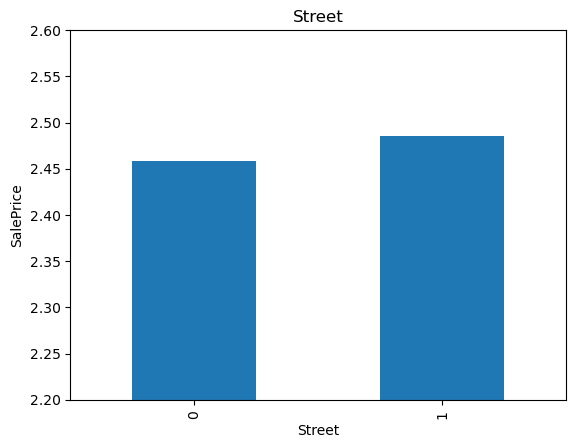
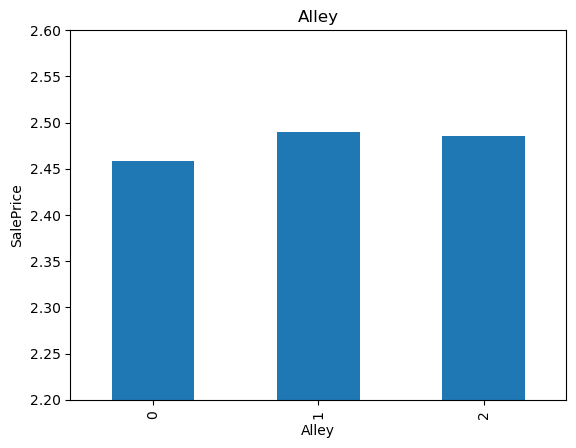


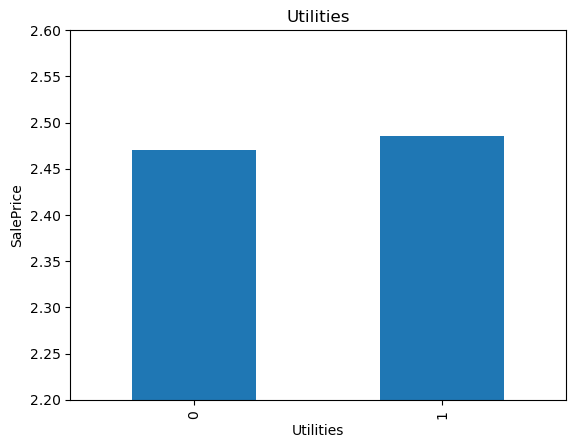

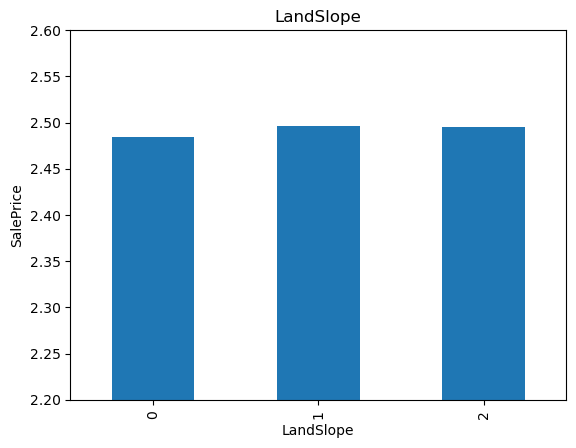

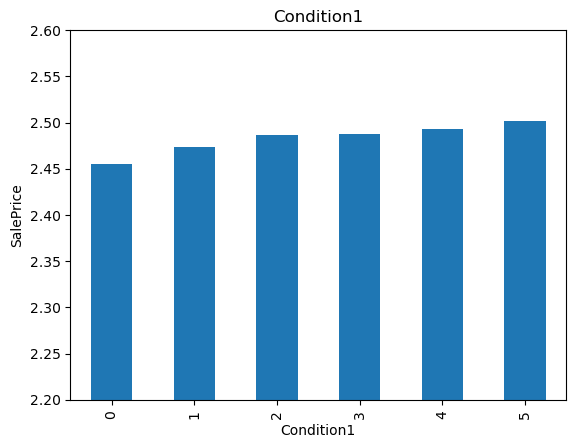
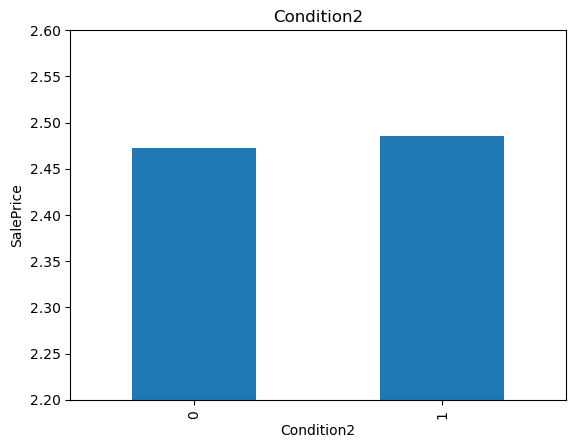
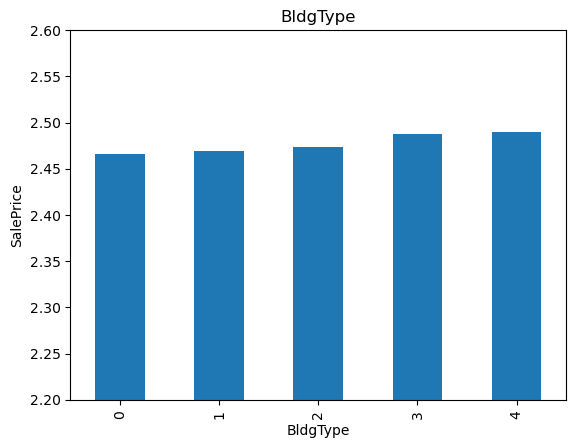



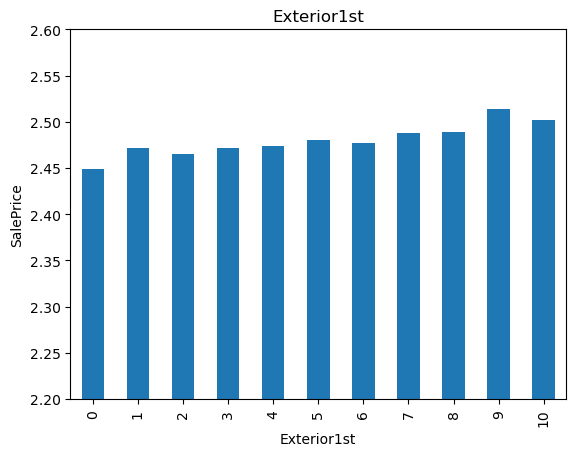
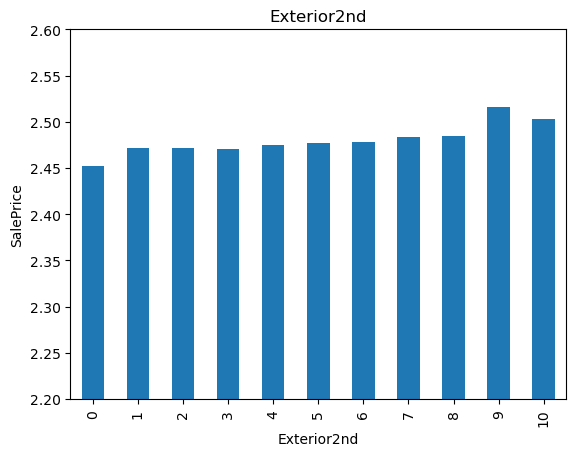
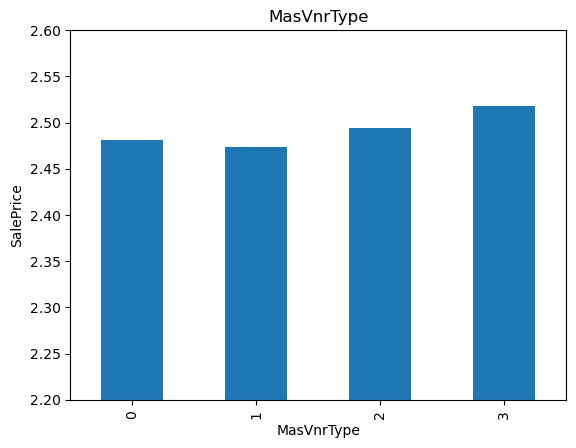
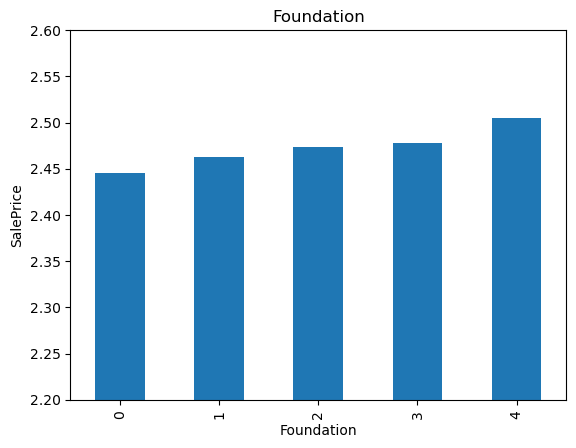

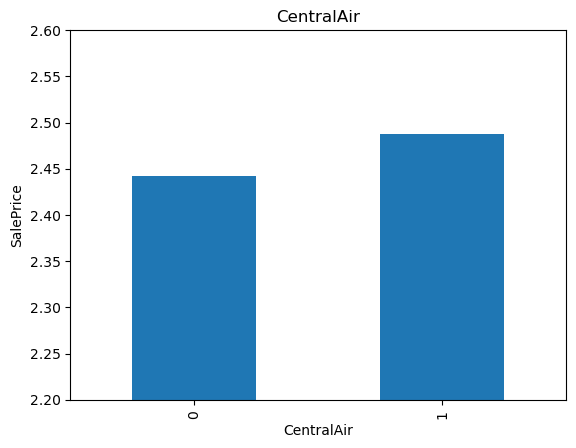
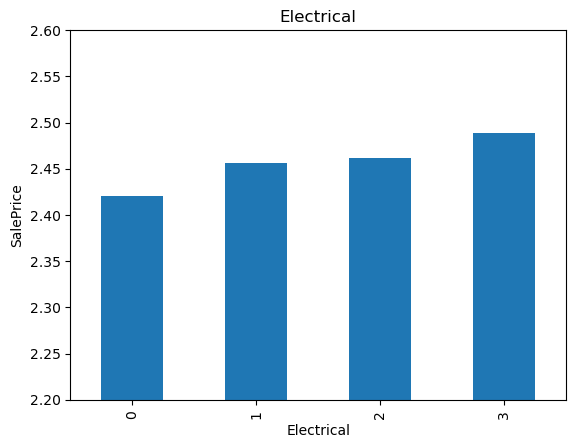
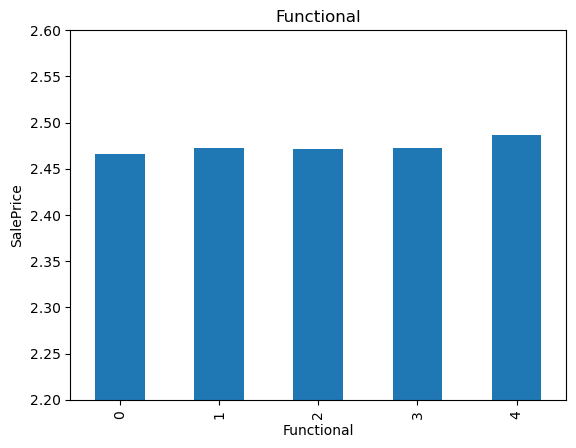
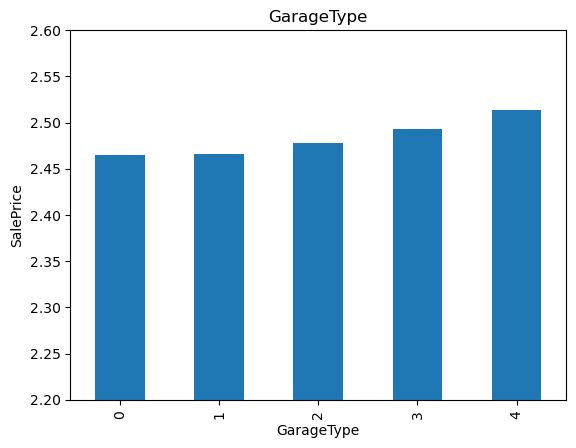
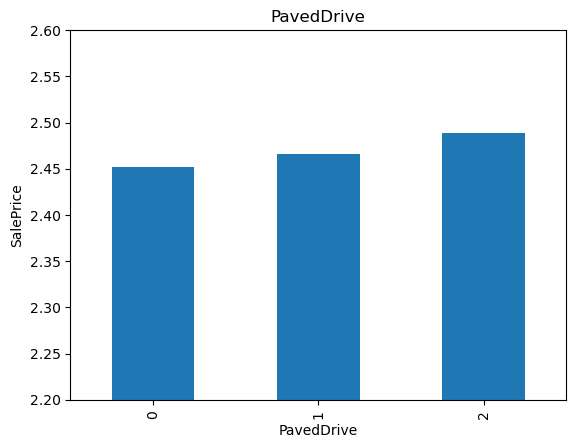
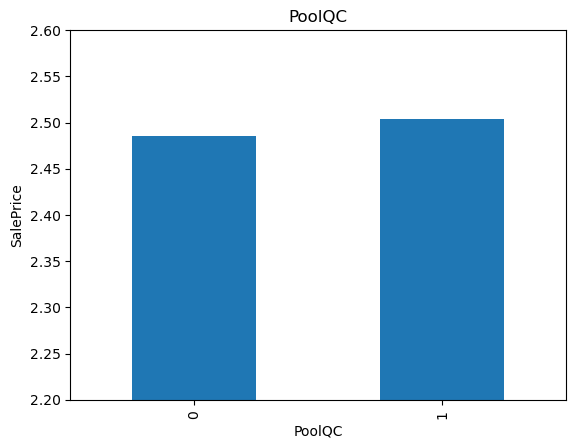
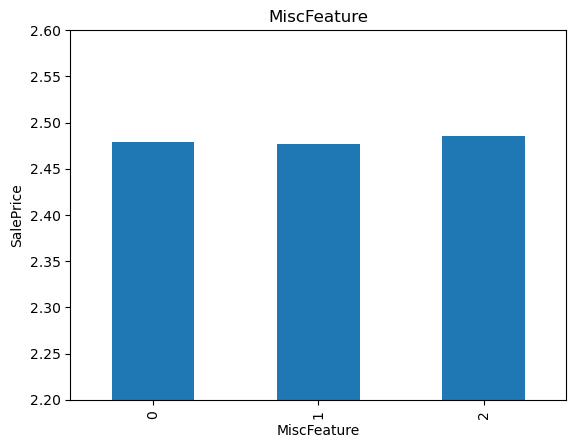
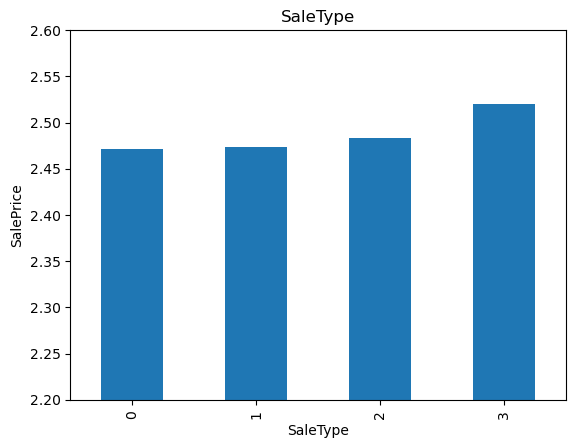
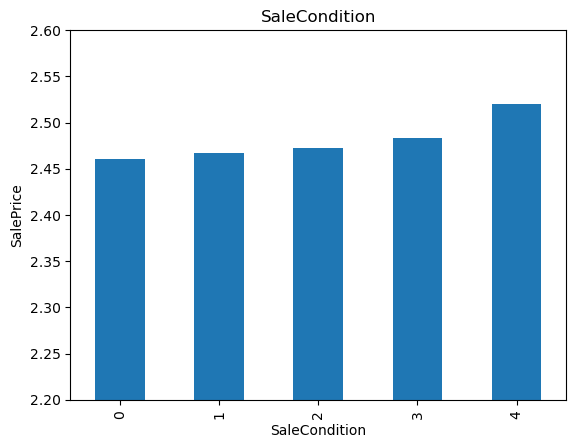
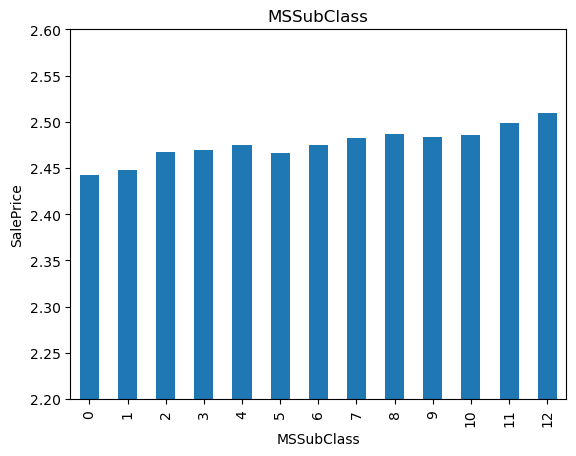
The monotonic relationship is particularly clear for the variables MSZoning and Neighborhood. Note how, the higher the integer that now represents the category, the higher the mean house sale price.
(The target is log-transformed, that is why the differences seem so small).
Feature Scaling#
For use in linear models, features need to be scaled. Scaling features to the minimum and maximum values:
1# create scaler
2scaler = MinMaxScaler()
3
4# fit the scaler to the train set
5scaler.fit(X_train)
6
7# transform the train and test set
8
9# sklearn returns numpy arrays, so we wrap the
10# array with a pandas dataframe
11
12X_train = pd.DataFrame(scaler.transform(X_train), columns=X_train.columns)
13
14X_test = pd.DataFrame(scaler.transform(X_test), columns=X_train.columns)
1X_train.head()
| MSSubClass | MSZoning | LotFrontage | LotArea | Street | Alley | LotShape | LandContour | Utilities | LotConfig | LandSlope | Neighborhood | Condition1 | Condition2 | BldgType | HouseStyle | OverallQual | OverallCond | YearBuilt | YearRemodAdd | RoofStyle | RoofMatl | Exterior1st | Exterior2nd | MasVnrType | MasVnrArea | ExterQual | ExterCond | Foundation | BsmtQual | BsmtCond | BsmtExposure | BsmtFinType1 | BsmtFinSF1 | BsmtFinType2 | BsmtFinSF2 | BsmtUnfSF | TotalBsmtSF | Heating | HeatingQC | CentralAir | Electrical | 1stFlrSF | 2ndFlrSF | LowQualFinSF | GrLivArea | BsmtFullBath | BsmtHalfBath | FullBath | HalfBath | BedroomAbvGr | KitchenAbvGr | KitchenQual | TotRmsAbvGrd | Functional | Fireplaces | FireplaceQu | GarageType | GarageYrBlt | GarageFinish | GarageCars | GarageArea | GarageQual | GarageCond | PavedDrive | WoodDeckSF | OpenPorchSF | EnclosedPorch | 3SsnPorch | ScreenPorch | PoolArea | PoolQC | Fence | MiscFeature | MiscVal | MoSold | SaleType | SaleCondition | LotFrontage_na | MasVnrArea_na | GarageYrBlt_na | |
|---|---|---|---|---|---|---|---|---|---|---|---|---|---|---|---|---|---|---|---|---|---|---|---|---|---|---|---|---|---|---|---|---|---|---|---|---|---|---|---|---|---|---|---|---|---|---|---|---|---|---|---|---|---|---|---|---|---|---|---|---|---|---|---|---|---|---|---|---|---|---|---|---|---|---|---|---|---|---|---|---|---|
| 0 | 0.750000 | 0.75 | 0.461171 | 0.366365 | 1.0 | 1.0 | 0.333333 | 1.000000 | 1.0 | 0.0 | 0.0 | 0.863636 | 0.4 | 1.0 | 0.75 | 0.6 | 0.777778 | 0.50 | 0.014706 | 0.049180 | 0.0 | 0.0 | 1.0 | 1.0 | 0.333333 | 0.00000 | 0.666667 | 0.5 | 1.0 | 0.666667 | 0.666667 | 0.666667 | 1.0 | 0.002835 | 0.0 | 0.0 | 0.673479 | 0.239935 | 1.0 | 1.00 | 1.0 | 1.0 | 0.559760 | 0.0 | 0.0 | 0.523250 | 0.000000 | 0.0 | 0.666667 | 0.0 | 0.375 | 0.333333 | 0.666667 | 0.416667 | 1.0 | 0.000000 | 0.0 | 0.75 | 0.018692 | 1.0 | 0.75 | 0.430183 | 0.5 | 0.5 | 1.0 | 0.116686 | 0.032907 | 0.0 | 0.0 | 0.0 | 0.0 | 0.0 | 0.00 | 1.0 | 0.0 | 0.545455 | 0.666667 | 0.75 | 0.0 | 0.0 | 0.0 |
| 1 | 0.750000 | 0.75 | 0.456066 | 0.388528 | 1.0 | 1.0 | 0.333333 | 0.333333 | 1.0 | 0.0 | 0.0 | 0.363636 | 0.4 | 1.0 | 0.75 | 0.6 | 0.444444 | 0.75 | 0.360294 | 0.049180 | 0.0 | 0.0 | 0.6 | 0.6 | 0.666667 | 0.03375 | 0.666667 | 0.5 | 0.5 | 0.333333 | 0.666667 | 0.000000 | 0.8 | 0.142807 | 0.0 | 0.0 | 0.114724 | 0.172340 | 1.0 | 1.00 | 1.0 | 1.0 | 0.434539 | 0.0 | 0.0 | 0.406196 | 0.333333 | 0.0 | 0.333333 | 0.5 | 0.375 | 0.333333 | 0.666667 | 0.250000 | 1.0 | 0.000000 | 0.0 | 0.75 | 0.457944 | 0.5 | 0.25 | 0.220028 | 0.5 | 0.5 | 1.0 | 0.000000 | 0.000000 | 0.0 | 0.0 | 0.0 | 0.0 | 0.0 | 0.75 | 1.0 | 0.0 | 0.636364 | 0.666667 | 0.75 | 0.0 | 0.0 | 0.0 |
| 2 | 0.916667 | 0.75 | 0.394699 | 0.336782 | 1.0 | 1.0 | 0.000000 | 0.333333 | 1.0 | 0.0 | 0.0 | 0.954545 | 0.4 | 1.0 | 1.00 | 0.6 | 0.888889 | 0.50 | 0.036765 | 0.098361 | 1.0 | 0.0 | 0.3 | 0.2 | 0.666667 | 0.25750 | 1.000000 | 0.5 | 1.0 | 1.000000 | 0.666667 | 0.000000 | 1.0 | 0.080794 | 0.0 | 0.0 | 0.601951 | 0.286743 | 1.0 | 1.00 | 1.0 | 1.0 | 0.627205 | 0.0 | 0.0 | 0.586296 | 0.333333 | 0.0 | 0.666667 | 0.0 | 0.250 | 0.333333 | 1.000000 | 0.333333 | 1.0 | 0.333333 | 0.8 | 0.75 | 0.046729 | 0.5 | 0.50 | 0.406206 | 0.5 | 0.5 | 1.0 | 0.228705 | 0.149909 | 0.0 | 0.0 | 0.0 | 0.0 | 0.0 | 0.00 | 1.0 | 0.0 | 0.090909 | 0.666667 | 0.75 | 0.0 | 0.0 | 0.0 |
| 3 | 0.750000 | 0.75 | 0.445002 | 0.482280 | 1.0 | 1.0 | 0.666667 | 0.666667 | 1.0 | 0.0 | 0.0 | 0.454545 | 0.4 | 1.0 | 0.75 | 0.6 | 0.666667 | 0.50 | 0.066176 | 0.163934 | 0.0 | 0.0 | 1.0 | 1.0 | 0.333333 | 0.00000 | 0.666667 | 0.5 | 1.0 | 0.666667 | 0.666667 | 1.000000 | 1.0 | 0.255670 | 0.0 | 0.0 | 0.018114 | 0.242553 | 1.0 | 1.00 | 1.0 | 1.0 | 0.566920 | 0.0 | 0.0 | 0.529943 | 0.333333 | 0.0 | 0.666667 | 0.0 | 0.375 | 0.333333 | 0.666667 | 0.250000 | 1.0 | 0.333333 | 0.4 | 0.75 | 0.084112 | 0.5 | 0.50 | 0.362482 | 0.5 | 0.5 | 1.0 | 0.469078 | 0.045704 | 0.0 | 0.0 | 0.0 | 0.0 | 0.0 | 0.00 | 1.0 | 0.0 | 0.636364 | 0.666667 | 0.75 | 1.0 | 0.0 | 0.0 |
| 4 | 0.750000 | 0.75 | 0.577658 | 0.391756 | 1.0 | 1.0 | 0.333333 | 0.333333 | 1.0 | 0.0 | 0.0 | 0.363636 | 0.4 | 1.0 | 0.75 | 0.6 | 0.555556 | 0.50 | 0.323529 | 0.737705 | 0.0 | 0.0 | 0.6 | 0.7 | 0.666667 | 0.17000 | 0.333333 | 0.5 | 0.5 | 0.333333 | 0.666667 | 0.000000 | 0.6 | 0.086818 | 0.0 | 0.0 | 0.434278 | 0.233224 | 1.0 | 0.75 | 1.0 | 1.0 | 0.549026 | 0.0 | 0.0 | 0.513216 | 0.000000 | 0.0 | 0.666667 | 0.0 | 0.375 | 0.333333 | 0.333333 | 0.416667 | 1.0 | 0.333333 | 0.8 | 0.75 | 0.411215 | 0.5 | 0.50 | 0.406206 | 0.5 | 0.5 | 1.0 | 0.000000 | 0.000000 | 0.0 | 1.0 | 0.0 | 0.0 | 0.0 | 0.00 | 1.0 | 0.0 | 0.545455 | 0.666667 | 0.75 | 0.0 | 0.0 | 0.0 |
Conclusion#
We now have several classes with parameters learned from the training dataset, that we can store and retrieve at a later stage, so that when a colleague comes with new data, we are in a better position to score it faster.
Still:
we would need to save each class
then we could load each class
and apply each transformation individually.
Which sounds like a lot of work.
The good news is, we can reduce the amount of work, if we set up all the transformations within a pipeline.
IMPORTANT
In order to set up the entire feature transformation within a pipeline, we still need to create a class that can be used within a pipeline to map the categorical variables with the arbitrary mappings, and also, to capture elapsed time between the temporal variables.

